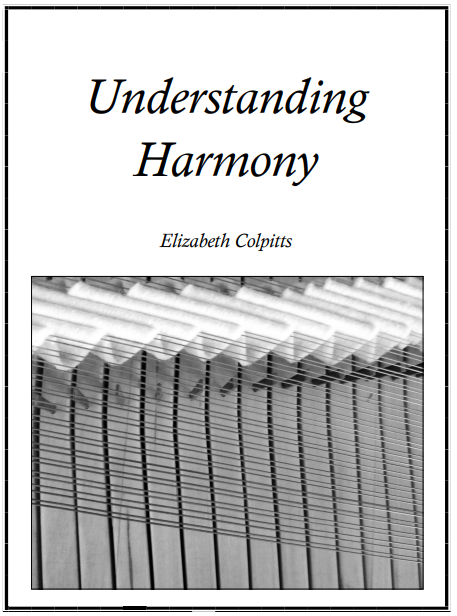What’s in the book
Understanding Harmony is 338 pages (8.5 in x 11) bound with a coil binding. Each chapter includes instruction and exercises to complete. Following each chapter there is a review quiz.

Purchase of the text also gives access to the Understanding Harmony EXTRAS section (password required) of this website where you may download pdf files of updates and double-sided study notes. Directions about how to get the Extras password are in the text.
The answer key for Understanding Harmony is intended for teachers and for students engaged in self-directed study. Directions about how to get the free answer key pdf file are in the text.
Understanding Harmony Chapter Notes
Chapter One: Triads
- A review of triads
- Triads in major and minor keys
- Writing triads in four parts, including considerations of range and spacing
- Writing tonic, dominant and subdominant triads in four parts
- Writing secondary triads in four parts
- Writing triads in keyboard style
- Avoiding errors of crossed parts
Chapter Review Quiz (found at the end of each chapter)
Chapter Two: Moving from one chord to the next
- Voice leading
- Common note voice leading
- Writing V – I and I – V
- Types of motion
- Contrary motion to the bass
- Octaves, fifths and unisons in progressions
- Using chord charts
Chapter Three: Chords in first inversion
- First inversion triads
- Avoiding errors of overlapping
Chapter Four: Dominant seventh chords 1
- Writing and resolving dominant seventh chords (complete-incomplete)
- Writing and resolving inverted dominant seventh chords
Roundup: Chapters One to Four
- Exercises based on the first four chapters
Chapter Five: Introduction to non-chord tones
- The passing tone, neighbour tone and appoggiatura
- Direct octaves and fifths
Chapter Six: Cadences
- Authentic, half, plagal, and deceptive cadences
- Perfect and Imperfect authentic cadences
- Cadences in four-part harmony and in contrapuntal style
Chapter Seven: More seventh chords
- Seventh chords: dominant seventh, major seventh, minor seventh, half diminished seventh, diminished seventh.
- Avoiding melodic augmented intervals
Chapter Eight: Root/quality chord symbols
- Root/quality chord symbols for triads
- Root/quality chord symbols for seventh chords
Chapter Nine: The cadential 6/4
- Writing the cadential 6/4
- The mediant triad
- The leading tone triad
Chapter Ten: Introduction to eighteenth-century dances
- Characteristics of some eighteenth-century dances
- Antecedent and consequent phrases in a period
Chapter Eleven: Analyzing eighteenth-century dances 1
- Marking the phrases in a dance
- Naming the cadences in a dance
Chapter Twelve: Harmonic progressions
- The order of chords in major and minor progressions
- Harmonic rhythm
Chapter Thirteen: Supertonic seventh chords
- Writing supertonic seventh chords
Chapter Fourteen: More chords in minor keys
- Chords using the raised submediant
- Chords using the subtonic
- Sequences in major and minor keys
Chapter Fifteen: Non-chord tones
- Review of the passing tone and neighbour tone
- The échappée
- The anticipation
- The incomplete neighbor tone
- The appoggiatura (review)
- The suspension
- Analysis
Chapter Sixteen: Second inversion chords
- The arpeggio 6/4 chord
- The neighboring 6/4 chord
- The passing 6/4 chord
- The credential 6/4 chord (review)
- Harmonizing a given Melody
Chapter Seventeen: Leading tone triads
- Writing leading tone triads
- Using leading tone triads in progressions
- Two tonic progressions: I – IV – I and I – iii.
- Changing tones
- Pedal point
- Chromatic non-chord tones
Chapter Eighteen: Dominant seventh chords 2
- Writing V7 – I as a complete-incomplete progression, an incomplete-complete progression, or a complete-complete progression
- The rising resolution V4/3 – I6
Chapter Nineteen: Applied dominant chords
- Writing applied dominant progressions in major keys
- Handling chromatic notes in progressions
- Writing applied dominant progressions in minor keys
Chapter Twenty: Modulation
- Modulation using a pivot chord
- Phrasal modulation
- Notes with accidentals: an overview
Chapter Twenty-One: Chorales
- Completing a chorale question
- Setting text
Chapter Twenty-Two: Analyzing eighteenth-century dances 2
- Dances in binary and ternary form
- Analyzing the form of a dance
- Analyzing two-part inventions
Chapter Twenty-Three: Writing melodies 1
- Overview of a sixteen-measure dance
- Tips for completing the melody and bass line
- Writing melodies in 6/8 time
Chapter Twenty-Four: Writing melodies 2
- Composing melodies with good rhythmic design, shape, use of steps and leaps, and range
- Writing melodies in minor keys
- Writing a melody above a given bass line
Appendix One: Phrase endings for authentic cadences
Appendix Two: The exam
Appendix Three: Quick reference that includes vocal ranges, names for non-chord tones, key signatures, and root/quality chord symbols
Index
